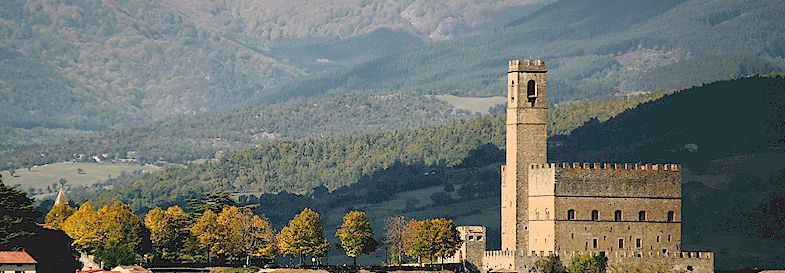
|

|

|

|

|

|

|

|

|

|

|

|

|

|

|

|

|

|

|

|

|

|

|
Poppi and the Castle of Poppi (Castello Poppi) |
|

|

Poppi Castle (Castello Poppi) |
|

|
|
|

|
|
|

|
The municipality of Poppi in the Valdarno Casentinese covers 97 sq km, extending from the ridge of the Tosco-Romagnolo Apennines to the floor of the Arno valley, centred on a terraced hillock that dominates the Campaldino plain and the valley of the Upper Arno. It was a fiefdom of the Counts Guidi of Battifolle and later became a Vicariate Seat.
The first historical record of Poppi dates from 1169, when it was cited in a document as belonging to the Abbey of San Fedele di Strumi. In a more significant document of 1191, Poppi, Battifolle and Porciano, together with many other castles on the borders of Tuscany and Emilia Romagna, were confirmed as a fief of Count Guido Guerra dei Guidi by the Emperor Arrigo VI. For the next three centuries, the history of Poppi was intertwined with that of its Lords, who were, for a long time, among the most powerful of the Tuscan feudal nobles and often protagonists in the principal events of Florentine politics of the 12 C and 13 C. In 1261, Count Simone fortified the town and began the construction of the palace, which was finished towards the end of the century by his son Guido. The Guidi di Poppi were Ghibellines and as such were forced, after the death of King Manfredi in 1266, to make an act of submission to the Guelfs who were dominant in Florence. On 11 June 1289, in the plain of Campaldino close to the walls of the castle, the historic Battle of Campaldino was fought between Florence and Arezzo, confirming the predominance of Florence and the Guelf party in Tuscany, even if for the moment without any acquisition of territory. The next year, the Florentines, returning from an unfruitful expedition against Arezzo and out of hatred for the Count Guido Novello who had been Vicariate General to King Manfredi in Florence, devastated the Casentino, setting on fire the Castle of Poppi. Finally in 1440, during an assault by the Milanese forces under the command of Niccolò Piccinino, Count Francesco dei Guidi, who had favoured the enemies of Florence after the Florentine victory at Anghiari , was besieged in his castle and forced to surrender. Passing into the possession of the Florentine republic, Poppi became Vicariate Seat with jurisdiction covering the whole of the Casentino.
Famous natives of Poppi the sculptor Mino, called da Fiesole (1430-1484), the artist Francesco Morandini, called il Poppi (1544-1597) and the free thinker and poet Tommaso Crudeli (1703-1745).
Main sights in and near PoppiPoppi Castle, a very impressive castellated palace positioned to dominate the valley. It was constructed in the second half of the 1200s as a strengthener to the fortress. In the front there is a large garden. The Castle of Poppi is thus a 13 C construction with successive Renaissance additions and embellishments. Externally it resembles the Palazzo Vecchio in Florence, of which it may be considered the prototype, since it is probably the work of the same architect, Arnolfo di Cambio. The interior courtyard, the staircase, the great rooms with coffered ceilings are masterworks of Tuscan architecture. The chapel is decorated with frescoes by Taddeo Gaddi. The Castle of Poppi houses a great library of more than 25,000 volumes, including over 1000 manuscripts and incunabula.
Church of the Madonna del Morbo, a circular plan church started in 1657 and finished in 1705.
The ruins of the Abbey of Strumi (10 C) - initially Benedettine then Vallombrosine.
The Hermitage of Camaldoli, constructed at the beginning of the 11 C by San Romualdo, is located near the Apennine ridge, surrounded by thick fir and beech woods.
|
|
|

|

|

|

|

|

|

|

|

|

|

|

|

|

|

|

|

|

|

|

|

|

|

|
|
|